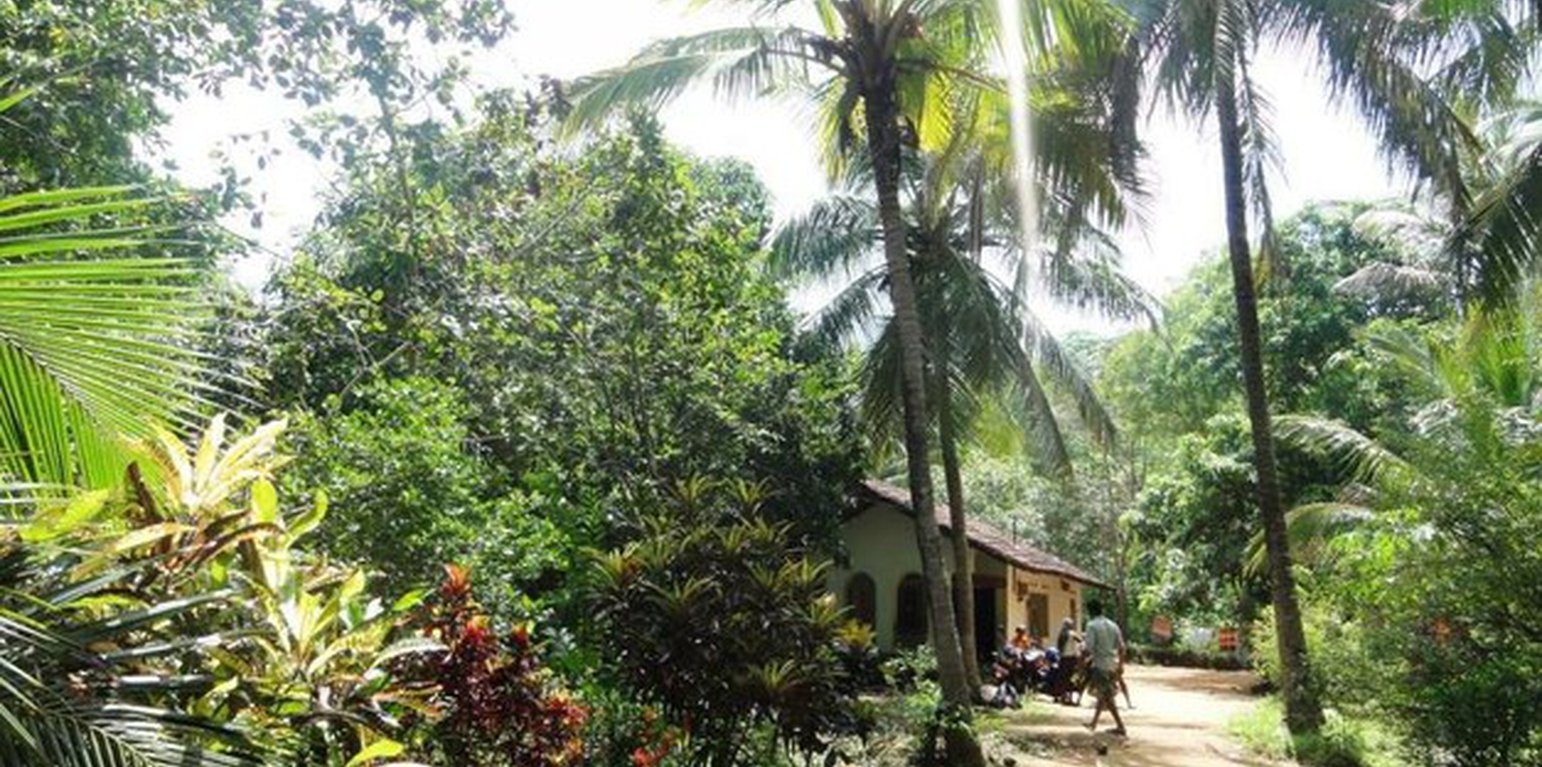



Home gardens are area where the cultivation of a small portion of land, usually around a homestead or within walking distance from the family home. Usually, a mixture of several crops that may include vegetables, fruits, plantation crops, spices, herbs, ornamental and medicinal plants as well as livestock that can serve as a supplementary source of food and income. Home gardens are a cropping system composed of soil, crops, weeds, pathogens and insects that convert resource inputs - solar energy, water, nutrients, labor, etc. - into food, feed, fuel, fiber and pharmaceuticals. Home gardens are important ways to ensure that the low-income households have access to the all the basic livelihood needs throughout the year. This is a resilience technology for resource-constrained farmers in remote parts of the world. During the wet season, farmers plant additional crops mainly vegetables to utilize the lower-storey niches because such crops are more shade tolerant. The multi-species and multi-canopy structure of the farming systems ensures stability against climate extremes such as drought, strong winds and dry spells.
The main features that characterize a home garden are (1) located near the residence; (2) containing a high diversity of plants; (3) production is supplemental rather than a main source of family consumption and income; (4) occupying a small area (~3 acres) and (5) requiring very low external inputs, relying mainly on recycling of crop residues and cow dung and seed from previous season’s harvest.
Home gardens play the role of producing subsistence items and generating additional income for the household. They are known for their stable yields, very varied products, continuous or repeated harvests during the year and low inputs. Whereas home gardens may not be the major sources of livelihood, they are known to contribute 10-35 percent of livelihoods of farmers and their productivity is reported to be up to 20 times that of other land uses such as irrigated fields, rise fields and fish ponds. home gardens are also an important source of nutrients providing approximately 10, 12, 150, 16, 31, 25 and 113 percent of the minimum daily requirement of protein, calcium, carotene, thiamine, riboflavin, niacin and ascorbic acid, respectively.
A large proportion of the products of home gardens is consumed by farmer families especially due to the remoteness of the area where a market economy has not yet developed. Home gardens also play sociol-cultural functions and provide products for religious rituals and ceremonies. The aesthetic role of home gardens is also considered important especially during the dry season when people spend evenings out in the garden. Hence, paying attention solely to the tangible economic and nutritional gains of home gardens, and agroforestry in general misses the various intangible ecological and social values.
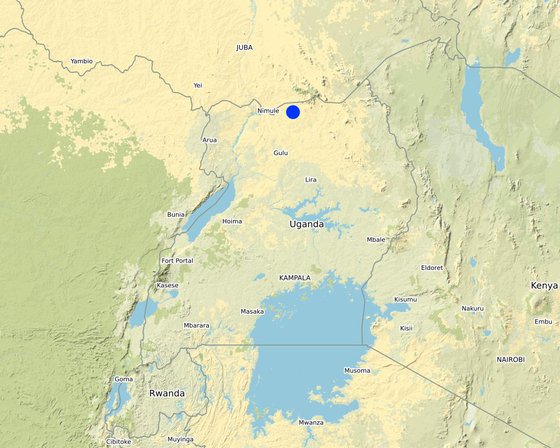
Байршил: Lamwo District, Northern Uganda, Уганда
Дүн шинжилгээнд хамрагдсан технологи нэвтрүүлсэн газрын тоо: 2-10 байршилд
Технологийн тархалт: газар дээр жигд тархсан (approx. < 0.1 км2 (10 га))
Хэрэгжилтийн огноо: 2008
Нутагшууллын төрөл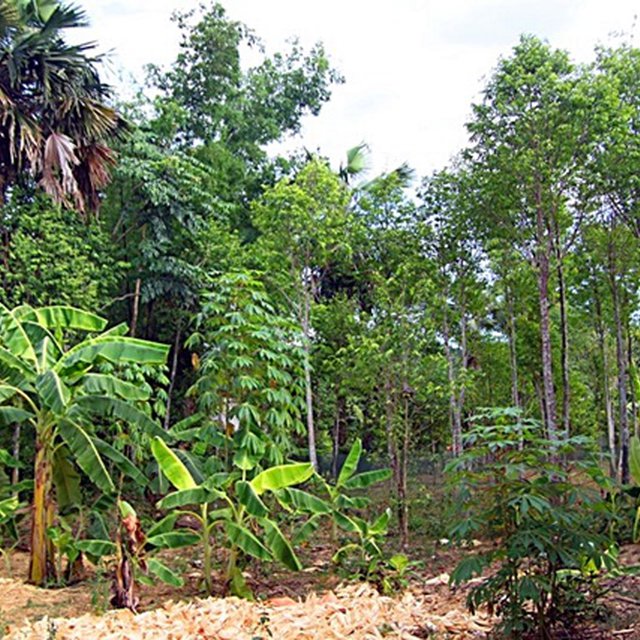
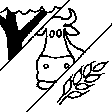





Техникийн үзүүлэлтүүдA typical multilayered Ugandan homegarden structure showing approximate heights for a diversity of edible species. Plants numbered: 1. Carica papaya, 2. Solanum betaceum, 3. Artocarpus heterophyllus, 4. Solanum tuberosum, 5. Manihot esculenta, 6. Zea mays, 7. Mangifera indica, 8. Ocimum gratissimum, 9. Solanum lycopersicum, 10. Musa spp., 11. Psidium guajava, 12. Ipomoea batatas, 13. Passiflora spp., 14. Amarathus spp., 15. Solanum aethiopicum, 16. Xanthasoma spp., 17. Physalis peruviana, 18. Cucurbita spp., and 19. Capsicum spp.
- Land area is approximately 3 acres -The mixture of plant species benefits form the various niches within the canopy -Taller, light demanders occupy the upper canopy while the shorter shade tolerant ones occupy the lower canopy - The homestead is within few meters (< 50 m) of the crop and livestock setting - Livestock shelter usually located under trees to protect them from hot sunshine - Kitchen residues are spread in the nearby are, providing fertility to the crops therein. Therefore, the plants nearer the house are generally more healthy - The home garden is more or less a closed system with limited external input or export of resources to outside |
|||||||||||
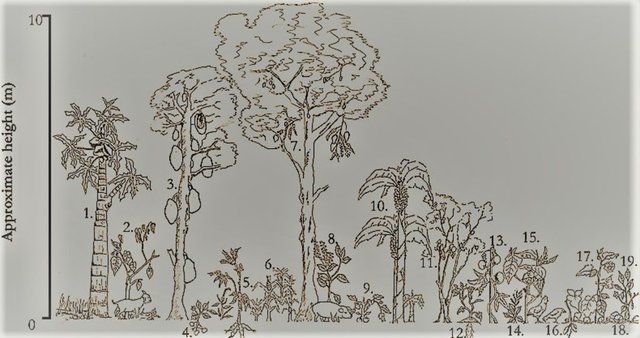
|
|||||||||||
| Зардлын нэр, төрөл | Хэмжих нэгж | Тоо хэмжээ | Нэгжийн үнэ (Uganda Shillings) | Зардал бүрийн нийт өртөг (Uganda Shillings) | Нийт дүнгээс газар ашиглагчийн төлсөн % |
| Хөдөлмөр эрхлэлт | |||||
| Planting | Days | 20.0 | 5000.0 | 100000.0 | 100.0 |
| Weeding | Days | 20.0 | 5000.0 | 100000.0 | 100.0 |
| Manure Management | Days | 20.0 | 5000.0 | 100000.0 | 100.0 |
| Pruning | Days | 20.0 | 5000.0 | 100000.0 | 100.0 |
| таримал материал | |||||
| Seeds | kg | 5.0 | 50000.0 | 250000.0 | 100.0 |
| Suckers and stem cuttings | pieces | 200.0 | 500.0 | 100000.0 | 100.0 |
| Бордоо ба биоцид | |||||
| Animal manure | kg | 2000.0 | 2000.0 | 4000000.0 | 100.0 |
| Барилгын материал | |||||
| Poles | Pieces | 100.0 | 5000.0 | 500000.0 | 100.0 |
| Nails | kg | 15.0 | 3000.0 | 45000.0 | 100.0 |
| Технологи бий болгох нийт үнэ өртөг | 5'295'000.0 | ||||
| Зардлын нэр, төрөл | Хэмжих нэгж | Тоо хэмжээ | Нэгжийн үнэ (Uganda Shillings) | Зардал бүрийн нийт өртөг (Uganda Shillings) | Нийт дүнгээс газар ашиглагчийн төлсөн % |
| Хөдөлмөр эрхлэлт | |||||
| Planting | Days | 20.0 | 5000.0 | 100000.0 | 100.0 |
| Weeding | Days | 20.0 | 5000.0 | 100000.0 | 100.0 |
| Manure management | Days | 20.0 | 5000.0 | 100000.0 | 100.0 |
| Pruning | Days | 20.0 | 5000.0 | 100000.0 | 100.0 |
| Тоног төхөөрөмж | |||||
| 3.0 | |||||
| таримал материал | |||||
| Seeds | kg | 2.0 | 30000.0 | 60000.0 | 100.0 |
| Suckers and stem cuttings | Pieces | 50.0 | 500.0 | 25000.0 | 100.0 |
| Бордоо ба биоцид | |||||
| Manure | kg | 2000.0 | 2000.0 | 4000000.0 | 100.0 |
| Барилгын материал | |||||
| Poles | Pieces | 30.0 | 5000.0 | 150000.0 | 100.0 |
| Nails | kg | 5.0 | 5000.0 | 25000.0 | 100.0 |
| Технологийн арчилгаа/урсгал үйл ажиллагаанд шаардагдах нийт үнэ өртөг | 4'660'000.0 | ||||
Better yields due to manure application from kitchen residues, soil erosion control and litter decomposition
Wood from pruning are used for cooking, reducing the need to walk long distances
Many crops and livestock products from the mixture of enterprises on the land
Most of the inputs e.g. seeds and manure come from with the farm, therefore low cost of inputs
So many small activities requiring labour all the time makes the workload big for the land manager
Continuous soil cover due to perennials such as trees
Litter fall and decomposition increases soil organic matter
Reduced runoff and erosion due to continuous soil cover